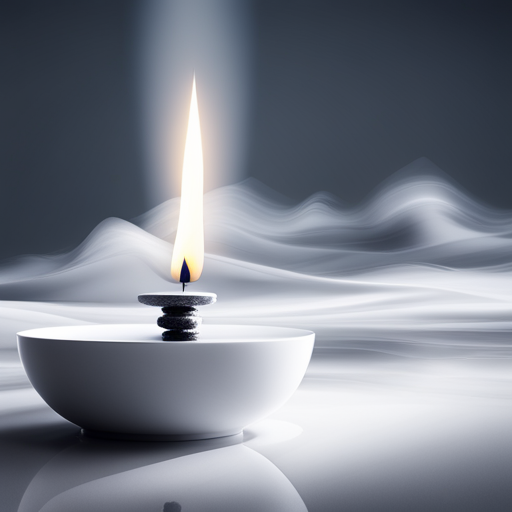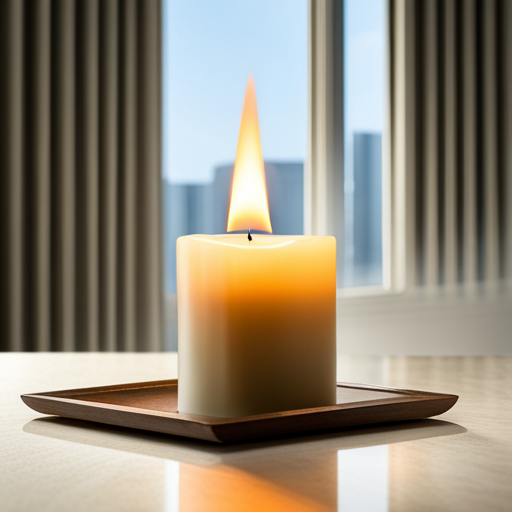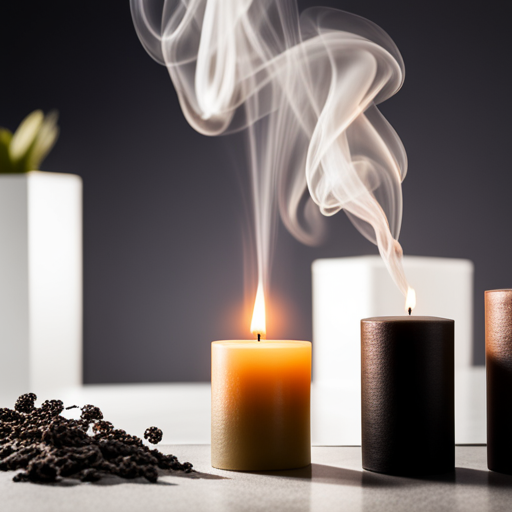To prevent candle blackening, it’s important to trim the wick, use high-quality candles, avoid drafts, and keep them away from heat sources. Cleaning and maintenance can be done by gently wiping the surface or using a mild soap solution. Troubleshooting may involve assessing the burning environment, examining the wick and wax quality, and seeking professional advice if needed.
Key Takeaways
– Candle blackening is caused by factors such as oxidation, unburned carbon atoms in the wax, long wicks and drafts, and low-quality candles.
– The science behind candle blackening involves oxidation during burning, incomplete combustion releasing unburned carbon atoms, and soot deposits caused by long wicks and drafts.
– Candle blackening can have negative effects, including decreased fragrance release, potential health risks from soot inhalation and irritation of the respiratory system, presence of harmful compounds like PAHs and VOCs, and hindering the diffusion of scent molecules.
– To prevent candle blackening, it is recommended to regularly trim the wick, use high-quality clean-burning candles, avoid drafts, keep candles away from heat sources, and use candle accessories like wick trimmers or snuffers.
The Science Behind Candle Blackening

https://www.youtube.com/watch?v=B9asozzeAwY
The science behind candle blackening is related to oxidation during the lifetime of the candle. Unburned carbon atoms contribute to black smoke, while long wicks and drafts lead to black soot deposits. Low-quality candles also burn unevenly and produce soot.
When a candle burns, it undergoes a chemical reaction known as oxidation. This process occurs as the heat from the flame reacts with the wax, breaking down its molecular structure and releasing carbon atoms. However, if the combustion is incomplete, some of these carbon atoms remain unburned and are released into the air as black smoke.
Additionally, long wicks and drafts can cause the flame to flicker and dance, leading to the deposition of black soot on surrounding surfaces.
Lastly, low-quality candles often contain impurities that cause them to burn unevenly, producing more soot.
Factors Contributing to Candle Blackening

Improper candle maintenance and burning conditions can lead to blackening. There are several factors that contribute to this issue:
– Oxidation during the lifetime of a candle can cause blackening.
– Unburned carbon atoms in the wax can contribute to the production of black smoke.
– Long wicks and drafts can lead to black soot deposits on the candle.
– Low-quality candles tend to burn unevenly, resulting in the formation of soot.
– The presence of blackening not only reduces the lifespan of the candle but also affects its fragrance release and overall appearance. Moreover, it increases indoor air pollution and poses potential health risks from soot inhalation.
To prevent candle blackening, it is important to follow some maintenance practices such as trimming the wick, using high-quality candles, avoiding drafts, keeping candles away from heat sources, and using appropriate candle accessories.
Cleaning and maintenance of blackened candles involve gentle wiping, using mild soap solutions, avoiding abrasive materials, and regularly inspecting and cleaning candle holders or containers. If the issue persists, seeking professional advice is recommended.
Negative Effects of Candle Blackening

Exposure to blackened candles can lead to decreased fragrance release and potential health risks from soot inhalation. When candles turn black, it indicates an incomplete combustion process, causing the release of soot particles into the air. These particles can irritate the respiratory system and may contain harmful compounds such as polycyclic aromatic hydrocarbons (PAHs) and volatile organic compounds (VOCs).
Inhaling these substances can lead to respiratory problems, allergies, and even long-term health issues. Furthermore, blackened candles also emit less fragrance due to the build-up of soot on the wick and candle surface, hindering the diffusion of scent molecules.
To avoid these negative effects, it is important to properly maintain candles, ensuring they burn cleanly and evenly. Regularly trimming the wick, using high-quality candles, and keeping them away from drafts can help minimize blackening and reduce the associated health risks.
Tips for Preventing Candle Blackening

To prevent candle blackening, individuals can regularly trim the wick to 1/4 inch before each use. This simple step helps to control the amount of carbon buildup and reduces the chances of black smoke and soot formation.
Additionally, there are several other tips that can be followed to prevent candle blackening:
– Use high-quality, clean-burning candles: Lower quality candles often contain impurities that contribute to blackening. Opting for cleaner-burning options can minimize this issue.
– Avoid drafts that can cause uneven burning: Drafts can cause the flame to flicker and burn unevenly, leading to increased black soot deposits.
– Keep candles away from heat sources: Placing candles near heat sources can cause them to burn hotter and produce more soot.
– Use candle accessories like wick trimmers or snuffers: These tools can help maintain the wick length and prevent excessive carbon buildup.
– Regularly inspect and clean candle holders or containers: Accumulated soot on holders or containers can transfer to the candle, causing blackening. Regular cleaning helps to prevent this.
Following these tips can help individuals enjoy their candles without the unsightly and potentially harmful effects of blackening.
How to Clean and Maintain Blackened Candles

Regularly inspecting and cleaning candle holders or containers helps to prevent the transfer of accumulated soot, maintaining the appearance and performance of blackened candles. By removing the soot buildup, the candles can burn more evenly and emit a stronger fragrance. To clean blackened candles, gently wipe the surface with a soft cloth or use a mild soap solution for stubborn stains. Avoid using abrasive materials that could damage the candle. It is important to allow the candle to cool before cleaning. Additionally, troubleshooting the cause of blackening can help prevent future issues. Check the burning environment, trim the wick properly, assess the quality of the candle wax, and consider storage conditions. Seeking professional advice may be necessary if the problem persists or worsens.
| Cleaning and Maintenance of Blackened Candles |
|---|
| – Gently wipe the surface with a soft cloth |
| – Use a mild soap solution to remove stubborn stains |
| – Avoid using abrasive materials that can damage the candle |
| – Allow the candle to cool before cleaning |
Troubleshooting Candle Blackening Issues

Inspecting the burning environment, trimming the wick properly, and assessing the quality of the candle wax can help troubleshoot issues with blackening.
When troubleshooting blackened candles, it is important to consider the candle’s burning environment. Factors such as drafts, heat sources, and the presence of other air pollutants can contribute to blackening.
Additionally, examining the wick for proper trimming is crucial, as long wicks can lead to black soot deposits.
Assessing the quality of the candle wax is also important, as low-quality candles tend to burn unevenly and produce more soot.
Finally, considering the candle’s age and storage conditions can provide valuable insights into the cause of blackening.
Seeking professional advice is recommended if the issue persists or worsens.
Common Myths About Candle Blackening

Trimming the wick to the proper length before each use can help prevent common misconceptions about candle blackening.
Many people believe that the blackening of candles is solely due to the quality of the wax or the brand of the candle. However, this is not entirely true.
While low-quality candles may contribute to blackening, the main culprit is often the wick. When the wick is too long, it produces excessive heat and causes the candle to burn unevenly, resulting in black soot deposits.
By regularly trimming the wick to about 1/4 inch, the flame remains controlled and the candle burns more cleanly.
This simple practice can help prolong the lifespan of the candle, improve fragrance release, and prevent the unsightly appearance of blackened candles.
Expert Advice on Dealing With Candle Blackening

An expert suggests using high-quality, clean-burning candles to reduce the occurrence of blackening. By using these types of candles, individuals can minimize the effects of blackening and enjoy a longer lifespan, increased fragrance release, and a cleaner appearance.
Furthermore, using high-quality candles can help decrease indoor air pollution and reduce potential health risks associated with soot inhalation.
To prevent candle blackening, it is important to trim the wick to 1/4 inch before each use, avoid drafts that can cause uneven burning, and keep candles away from heat sources. Additionally, using candle accessories like wick trimmers or snuffers can aid in preventing blackening.
Regular cleaning and maintenance of blackened candles is also necessary to maintain their appearance and functionality.
Does the Scent in Scented Candles Cause Them to Turn Black Faster?
Yes, the scent in scented candles can cause them to turn black faster compared to unscented candles. This is due to the added oils and chemicals in scented candles, which can create more soot when burned. It’s always best to be cautious when burning scented vs unscented candles burn速 for a cleaner and longer-lasting flame.
Frequently Asked Questions
How Long Does It Take for a Candle to Turn Black?
Candles can turn black within a few hours of burning, depending on factors like wick length and drafts. It is important to properly trim the wick and avoid drafts to prevent blackening.
Can Candle Blackening Be Harmful to My Health?
Candle blackening can be harmful to health. Inhaling soot from blackened candles may pose potential risks. It is important to maintain clean-burning, high-quality candles and properly trim the wick to minimize health hazards.
Are Scented Candles More Prone to Blackening Than Unscented Ones?
Scented candles are not necessarily more prone to blackening than unscented ones. The blackening of candles is primarily caused by factors like oxidation, unburned carbon atoms, long wicks, drafts, and low-quality candles.
Can Candle Blackening Be Prevented Completely?
Candle blackening can be prevented to some extent by trimming the wick, using high-quality candles, avoiding drafts, and keeping them away from heat sources. However, complete prevention may not be possible.
Is There a Way to Clean Blackened Candles Without Damaging Them?
Yes, there is a way to clean blackened candles without damaging them. Gently wipe the surface with a soft cloth or use a mild soap solution to remove stubborn stains. Avoid using abrasive materials.

